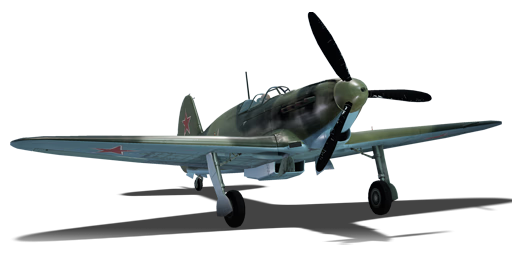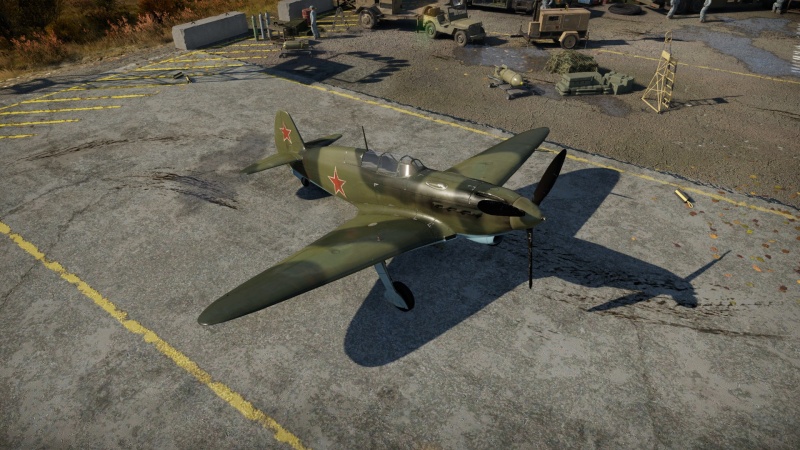Yak-7B
Contents
Description
The Yakovlev Yak-7B is the third variant of the Yak-7 fighter aircraft family. The Yak-7 began as a two-seat trainer designed to support the Yak-1 family, armed with only one 7.62 mm ShKAS light machine gun for gunnery practice and dual-control cockpits for the student and instructor. The Yak-7 factory's engineers immediately began work on a prospective single-seat fighter adaptation of the twin-seat Yak-7. Rather than removing the back instructor's space, it was retained for future possibilities. The single-seat Yak-7 was officially introduced in 1942 and had limited production. The Yak-7A went into service as an improved variant of the standard Yak-7, with around 300 aircraft constructed and introduced in late 1942. For improved high-altitude performance, this modified variant included the M-105PA V12 liquid-cooled inline piston engine with 1,050 horsepower. Initially, the Yak-7A was armed with one 20 mm ShVAK cannon firing through the propeller hub and two 7.62 mm ShKAS light machine guns in the engine cowling. This was later changed to two 12.7 mm Berezin UB heavy machine guns. The Yak-7B was the standard Yak-7's second improved variant. The Yak-7B featured a shorter wingspan, upgraded onboard equipment, and production-friendly improvements to the undercarriage over the Yak-7A. An incredible 5,000 aircraft were built to this specification.
Introduced in the Open Beta Test prior to Update 1.27, the Yak-7B is not as manoeuvrable as its cousins, but it is competitive nonetheless. It is critical that you stay close to friendly high-flying aircraft. If you are being aggressively pursued by enemy aircraft, consider pulling the opponent near your allies. As the ammunition count is limited, trigger discipline is required. Even without the Wartime Emergency Power (WEP), the Yak-7B is a competent climber. Maintaining altitude allows you to dive away if things become problematic in the middle of a fight with an enemy. Because the wings rip quickly, steep dives should be avoided. It is, however, a capable high-altitude aircraft, and in the hands of an experienced player, the Yak-7B can easily earn a few kills during battles.
General info
Flight performance
The aircraft has a lightweight body and a good engine making it very capable of dealing with any kind of enemy. It has decent manoeuvrability for its battle rating, although not as good as the other Yaks. It is most efficient up to 4,000 m (13,123 ft). It's not recommended to use in a turn fight, but if necessary extending the flaps helps a lot. It can climb well making flying away not so difficult. The Yak-7B can withstand from 10 G to -8 G.
| Characteristics | Max Speed (km/h at 3,650 m) |
Max altitude (metres) |
Turn time (seconds) |
Rate of climb (metres/second) |
Take-off run (metres) | |||
|---|---|---|---|---|---|---|---|---|
| AB | RB | AB | RB | AB | RB | |||
| Stock | 553 | 536 | 9900 | 22.3 | 23.0 | 13.2 | 13.0 | 320 |
| Upgraded | 587 | 570 | 20.7 | 21.5 | 18.0 | 15.5 | ||
Details
| Features | ||||
|---|---|---|---|---|
| Combat flaps | Take-off flaps | Landing flaps | Air brakes | Arrestor gear |
| X | X | ✓ | X | X |
| Limits | ||||||
|---|---|---|---|---|---|---|
| Wings (km/h) | Gear (km/h) | Flaps (km/h) | Max Static G | |||
| Combat | Take-off | Landing | + | - | ||
| 683 | 320 | N/A | N/A | 280 | ~11 | ~9 |
| Optimal velocities (km/h) | |||
|---|---|---|---|
| Ailerons | Rudder | Elevators | Radiator |
| < 380 | < 420 | < 490 | > 340 |
Survivability and armour
The aircraft can take a few hits in the engine and in the hull. It has 8 mm (0.31 in) of steel on the seat. You can avoid most of the enemy aircraft but stalling this fighter is a death wish. Any Bf 110 or the other Boom & Zoom type aircraft will knock your plane out. It's effective to gradually reduce your speed and make circles clockwise to make enemies overshoot.
Modifications and economy
Armaments
Offensive armament
The Yak-7B is armed with:
- 1 x 20 mm ShVAK cannon, nose-mounted (120 rpg)
- 2 x 12.7 mm Berezin UB machine guns, nose-mounted (260 rpg left + 140 rpg right = 400 total)
Suspended armament
The Yak-7B can be outfitted with the following ordnance:
- Without load
- 2 x 50 kg FAB-50sv bombs (100 kg total)
- 6 x ROS-82 rockets
- 6 x RBS-82 rockets
Usage in battles
The Yak-7B is a versatile aircraft that can destroy both air or ground targets.
The Yak-7B is not as manoeuvrable as its cousins in the tech tree but is decently competitive. Having a wingman with you can work wonders while flying the Yak-7B given both of you create opportunities for each other. The Yak-7B is not an aircraft that does good away from allies so it's essential that you remain in close proximity with other high-flying aircraft. If targeted actively and being chased, try dragging the enemy to the deck near allies.
The 20 mm ShVAK cannon and 12.7 mm Berezin UB MG combination is decent and will take down any aircraft with precise bursts. Ammunition count is on the lower side so trigger discipline is necessary. It is best to get close and fire when the Enemy aircraft is in middle of a turn or attempting a zoom climb, Targeting the wings or the cockpit.
The Yak-7B is a decent climber, even without the WEP being available, it can easily climb to ~4,000-4,500 m quickly on 100% engine power without issues. The engine temperature turns yellow rather quickly, but it stays there and does not get any higher. Maintaining altitude is recommended which allows you to dive away if things get difficult mid fight. The turn rate is on the higher side but careful manoeuvring can turn tables easily.
Steep dives are discouraged because the wings rip very quickly. It is best to either dive doing a shallow spiral or to do split-S if one wants to reduce altitude or lose an enemy. But, even if the wings tend to rip, the Yak is a fair BnZ aircraft and careful speed monitoring can get you kills while diving. The Yak-7B has good response to control inputs and does not feel sluggish.
Ground pounding is possible but is not recommended. The Yak can carry 2 x FAB-50 bombs that can destroy ground targets and rockets.
Manual Engine Control
| MEC elements | ||||||
|---|---|---|---|---|---|---|
| Mixer | Pitch | Radiator | Supercharger | Turbocharger | ||
| Oil | Water | Type | ||||
| Controllable | Controllable Not auto controlled |
Controllable Not auto controlled |
Controllable Not auto controlled |
Separate | Controllable 2 gears |
Not controllable |
Pros and cons
Pros:
- Powerful engine, even without WEP can climb at decent rate
- Nose-mounted 1 x 20 mm ShVAK & 2 x 12.7 mm UBS machine gun proves a very effective combination
- Capable of using rockets for both air and ground targets
Cons:
- No WEP, engine temperature readings turn yellow quickly
- Engine underperforms above 4,000 m, making the Yak-7B incapable of intercepting high-altitude bombers
- Worse manoeuvrability compared to all other low-tier Yakovlev fighters
- The wooden airframe can't sustain high compression during dive in high speed, resulting in wing rips above 650 km/h
- Any kind of fire will quickly spread across the plane
History
The Yakovlev Yak-7 was originally intended as a two-seat trainer version of the Yak-1 fighter plane for the Soviet Air Force and only armed with 1 x 7.62 mm ShKAS MG for gunnery practice. Eventually, engineers at the Yakovlev Design Bureau modified the plane into a single-seat fighter superior to the Yak-1. The plane was armed with a single, propeller-mounted 20 mm ShVAK autocannon and 2 x ShKAS machine guns in the engine cowling and included armour for the cockpit. The plane was quickly adopted by the air force and production was approved by late 1941. Unfortunately, Operation Barbarossa, the German invasion of the USSR had already begun and the relocation of factories to the Urals and more pressing needs elsewhere meant only 65 were available at the end of the year. Though it would see service as a fighter and interceptor, the aircraft was more often used as a fighter-bomber due to its ability to carry bombs and rockets for use against the Nazi and Italian ground forces. The Yak-7B would be introduced in 1942 and had a reduced wingspan, improved on-board systems, and an easier-to-produce undercarriage compared to the Yak-7A. Production of the Yak-7B would amount to over 5,000 aircraft produced. It would later see service with Albania, Bulgaria, Hungary, Mongolia, Poland, and Yugoslavia, which only received 2 Yak-7V planes. The Free French Air Force Normandie-Niemen squadron would also employ the plane on the Eastern Front, eager to get revenge against the Luftwaffe that had bested them on the home front.
| Archive of the in-game description | |
|---|---|
|
This Soviet single-engine fighter was based on the Yak-7UTI, a tandem-seat advanced trainer based on the Yak-1. The first Yak-7B rolled off the production line at Yakovlev in 1942; the last one was made in 1944. The Yak-7B's armaments consisted of two 12.7 mm Berezin machine guns and one 20 mm ShVAK cannon. In addition, bombs aboard the plane could be suspended. In all, the plane's manufacturer made more than 5,000 Yak-7Bs. | |
Media
- Skins
See also
External links
| A.S. Yakovlev Design Bureau (Яковлев Опытное конструкторское бюро) | |
|---|---|
| Fighters | |
| Yak-1 | Yak-1 · Yak-1B |
| Yak-3 | Yak-3 · Eremin's Yak-3(e) · Yak-3 (VK-107) · Yak-3P · Yak-3T · Yak-3U |
| Yak-7 | Yak-7B |
| Yak-9 | Yak-9 · Yak-9B · Yak-9K · Golovachev's Yak-9M · Yak-9P · Yak-9T · Yak-9U · Yak-9UT |
| Twin-engine fighters | I-29 |
| Jet fighters | |
| Yak-15 | Yak-15P · Yak-15 |
| Yak-17 | Yak-17 |
| Yak-23 | Yak-23 |
| Yak-30 | Yak-30D |
| Yak-141 | Yak-141 |
| Strike aircraft | |
| Yak-2 | Yak-2 KABB |
| Yak-38 | Yak-38 · Yak-38M |
| Bombers | Yak-4 |
| Jet bombers | Yak-28B |
| Foreign use | ▄Yak-3 · Challe's ▄Yak-9T · ◔Yak-9P |
| Captured | ▀Yak-1B |
| USSR fighters | |
|---|---|
| I-15 | I-15 WR · I-15 M-22 · I-15 M-25 · I-15bis · Krasnolutsky's I-15bis |
| I-153 M-62 · Zhukovsky's I-153-M62 · I-153P | |
| I-16 | I-16 type 5 · I-16 type 10 · I-16 type 18 · I-16 type 24 · I-16 type 27 · I-16 type 28 · I-180S |
| I-29 | I-29 |
| I-185 | I-185 (M-71) · I-185 (M-82) |
| I-225 | I-225 |
| ITP | ITP (M-1) |
| MiG-3 | MiG-3-15 · MiG-3-15 (BK) · MiG-3-34 |
| LaGG | I-301 · LaGG-3-4 · LaGG-3-8 · LaGG-3-11 · LaGG-3-23 · LaGG-3-34 · LaGG-3-35 · LaGG-3-66 |
| La | La-5 · La-5F · La-5FN · La-7 · Dolgushin's La-7 · La-7B-20 · La-9 · La-11 |
| Yak-1/7 | Yak-1 · Yak-1B · Yak-7B |
| Yak-3 | Yak-3 · Eremin's Yak-3(e) · Yak-3P · Yak-3T · Yak-3U · Yak-3 (VK-107) |
| Yak-9 | Yak-9 · Yak-9B · Golovachev's Yak-9M · Yak-9T · Yak-9K · Yak-9U · Yak-9UT · Yak-9P |
| Other countries | ▂P-40E-1 · ▂P-47D-27 · ▂Hurricane Mk IIB · ▂Fw 190 D-9 · ▂Spitfire Mk IXc |
| P-39 | ▂P-39K-1 · ▂Pokryshkin's P-39N-0 · ▂P-39Q-15 |
| P-63 | ▂P-63A-5 · ▂P-63A-10 · ▂P-63C-5 |





